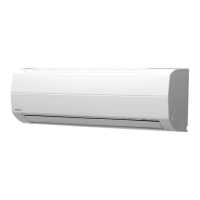
Do you have a question about the Toshiba RAS-24SKPX and is the answer not in the manual?
| Power Supply | 220-240V, 50Hz |
|---|---|
| Energy Efficiency Ratio (EER) | 3.21 |
| Coefficient of Performance (COP) | 3.61 |
| Refrigerant | R32 |
| Indoor Unit Weight | 14 kg |
| Type | Split System |
Exploded views and dimensions of the indoor air conditioner unit.
Exploded views and dimensions for the 18 Class outdoor unit.
Exploded views and dimensions for the 24 Class outdoor unit.
Wiring schematic for 18SKPX, 18S2AX, 18SKPX-V, 18S2AX-V, 18SKP-E, 18S2A-E.
Wiring schematic for 24SKPX, 24S2AX, 24SKP-E, 24S2A-E.
Specifications for indoor unit electrical components of 18 series models.
Specifications for outdoor unit electrical parts of 18 series models.
Specifications for indoor unit electrical components of 24 series models.
Specifications for outdoor unit electrical parts of 24 series models.
Refrigerant cycle diagram for 18 series models with operating conditions.
Refrigerant cycle diagram for 24 series models with operating conditions.
Explanation of the remote control buttons and their functions.
Description of the indicators and symbols displayed on the remote control.
General description of how the indoor and outdoor units control the air conditioner's operation.
How the vertical air flow louver is controlled and adjusted.
How the indoor fan speed is controlled in different modes.
Detailed explanations for Fan only, Cooling, and Dry operation modes.
How the unit operates in Fan only mode, including fan speed settings.
How the unit operates in Cooling mode, controlling compressor and fan.
How the unit operates in Dry mode, managing compressor and fan cycles.
How the unit automatically selects between Cooling and Fan only modes.
Description of safety features like low-temperature limit control and one-touch operation.
Prevents indoor heat exchanger freezing by controlling compressor and fan.
Explanation of the fully automated one-touch comfort operation.
How to activate and operate the Hi POWER mode for faster cooling.
How to activate QUIET mode for reduced noise levels.
Explanation of the ECO mode for energy saving.
How to use COMFORT SLEEP mode for quiet and energy-saving operation.
Information on the filter indicator light and how to reset it.
How the unit automatically restarts with previous settings after power loss.
Procedure to enable the auto restart function.
Procedure to disable the auto restart function.
Explanation of the self-cleaning function to maintain indoor unit cleanliness.
Diagram showing the operation of the self-cleaning mode.
Procedures for setting or canceling the self-cleaning function.
Critical safety warnings and precautions for installation personnel.
Visual guide for the physical installation of indoor and outdoor units.
Specific installation steps and required optional parts for mounting.
List of optional parts required for installation.
List of included accessories and installation hardware.
Detailed instructions for installing the indoor unit components.
Guidelines for selecting the optimal location for indoor unit installation.
Instructions for drilling holes and mounting the installation plate for the indoor unit.
Procedures for electrical connections and wiring for the indoor unit.
Steps for connecting the internal wiring and cables for the indoor unit.
Instructions for installing refrigerant pipes and drain hoses.
How to securely mount the indoor unit onto the installation plate.
Proper installation of the drain hose for effective water removal.
Guidelines for installing the outdoor unit of the air conditioner.
Criteria for selecting the proper location for the outdoor unit.
Steps for connecting the refrigerant pipes to the outdoor unit.
Procedure for evacuating air and moisture from the refrigerant system.
Instructions for connecting electrical wiring to the outdoor unit.
Procedures for performing a test run after installation.
How to check for refrigerant leaks after piping connection.
Steps to perform a functional test of the air conditioner.
How to configure the auto restart function.
How to set remote control modes for multiple units.
General steps to follow for troubleshooting issues.
Initial checks for power supply, connections, and program control.
Verifying the correct power supply voltage for operation.
Ensuring correct wiring between indoor and outdoor units.
Confirming the microcontroller operates as expected.
Initial diagnosis based on unit symptoms and lamp indicators.
Functions of the indoor unit controller in system operation.
How the unit self-diagnoses issues and indicates them via lamps.
Using the remote control to access and interpret diagnostic check codes.
Steps to enter service mode for remote control diagnostics.
Troubleshooting specific issues with the indoor unit.
Diagnosing why the indoor unit does not turn on.
Troubleshooting problems with the indoor fan motor operation.
Diagnosing and resolving problems with the compressor not operating.
Diagnosing issues related to interconnect and serial signal wiring.
Troubleshooting when the outdoor unit does not operate.
Diagnosing why the outdoor unit stops and restarts.
Procedures for troubleshooting issues related to the printed circuit board.
Steps to inspect and test the indoor unit's P.C. board.
How to adjust the restart delay timer setting.
Procedures for setting or canceling the self-cleaning function.
Steps to diagnose and resolve issues with the remote control.
Procedures for replacing parts of the indoor unit.
Procedures for replacing parts of the 18 series outdoor unit.
Procedures for replacing parts of the 24 series outdoor unit.
Exploded diagram and parts list for the indoor unit assembly.
Detailed parts list for the indoor unit with part numbers.
Exploded diagram and parts list for the 18 series outdoor unit.
Exploded diagram and parts list for the 24 series outdoor unit.











